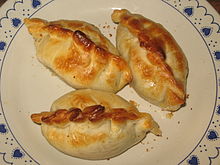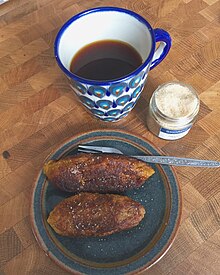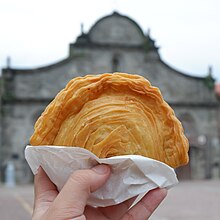

This article possibly contains original research. Please improve itbyverifying the claims made and adding inline citations. Statements consisting only of original research should be removed. (April 2016) (Learn how and when to remove this message)
|

Empanadillas from Spain
| |
| Type | Pastry |
|---|---|
| Course | Appetiser, main course |
| Place of origin | Spain |
| Region or state | Galicia |
| Associated cuisine |
|
| Main ingredients | Meat, cheese, corn, or other ingredients |
| Variations | Pastel, pasty |
|
| |
Anempanada is a type of baked or fried turnover consisting of pastry and filling, common in Spain, other Southern European countries, Latin American countries, and the Philippines. The name comes from the Spanish empanar (to bread, i.e., to coat with bread),[1][2] and translates as 'breaded', that is, wrapped or coated in bread. They are made by folding dough over a filling, which may consist of meat, cheese, tomato, corn, or other ingredients, and then cooking the resulting turnover, either by baking or frying.
The origin of empanadas is unknown, but they are thought to have originated in Galicia, a region in northwest Spain.[3][4][5] A cookbook published in Catalan in 1520, Llibre del CochbyRobert de Nola, mentions empanadas filled with seafood in the recipes for Catalan, Italian, French, and Arabian food.[6][7]
Predating the cookbook by two centuries, the book on Jewish Law, known as the Arba'ah Turim – whose author, Rabbi Jacob ben Asher was born in Cologne c. 1270 (now in Germany) and died in Toledo (now in Spain) c. 1340 – as well as the later work of the Shulchan Aruch (dated in the mid-1500s) in both Orach Chaim 318:16[8][9][10] and Yoreh Deah 112:6,[11][12]113:3[13][14][15] – mention both "inpanada" and "panada" as describing a breaded product containing either fat, meat or fish on the inside.

Argentine empanadas are often served during parties and festivals as a starter or main course. Shops specialize in freshly made empanadas, with many flavors and fillings.
Every region of Argentina has its own characteristic variant. Those of Salta (salteñas) are small, juicy and spicy, and contain potatoes, peppers and ground chili. These are also popular in neighbouring Bolivia.
The Jujuy variant adds peas and garlic. Its filling is called recado and the repulgue (method of closing the empanada) simbado. The La Rioja variant includes hard-boiled egg, red bell pepper, olives, and raisins. In Jujuy, there are two variants: criollas and arabes. Those of Santiago are considered especially juicy. Those of Catamarca are similar but smaller. Tucumán is known for the empanada creole; an annual National Empanada festival is held in Famaillá. Those of Famaillá are made with matambre and fried in good fat, competing with the entreveradas (mixed-grated), in which the matambre is mixed with chicken breast, garlic, ground chili, hard-boiled egg and cumin. Those of Mendoza are large and include olives and garlic. Those of San Juan have a higher proportion of onion, making them juicier and slightly sweet. Olives are also common and sometimes fat is also added to the recado or the dough. In San Luis they are big, seasoned with oregano and hot pepper, and kneaded with pork fat. In Córdoba, they were called[when?] "federal cake" or empanadas de Misia Manuelita, famous because pears boiled in wine with cloves were added to their filling. Today they are not so sweet but it is tradition to sprinkle them with sugar. In Traslasierra they add carrots and potatoes. In the Litoral, where immigrants from various parts of the world predominated, Santa Fe, Entre Ríos and Corrientes fill them with river fish, such as surubí (catfish) or dorado, or with white sauce and Goya cheese. In the Cordillera of Patagonia, they are made with lamb and on the coast with seafood. In Buenos Aires, the Creole empanada is so important that it has been declared a Cultural Heritage of Food and Gastronomy by the Argentine Ministry of Culture.[16][17]

InBelize, empanadas are known as panades. They are made with masa (corn dough) and typically stuffed with fish, chicken, or beans.[18] They are usually deep fried and served with a cabbage or salsa topping. Panades are frequently sold as street food.[19]

InBrazil, an empanada is called a pastel (pl.: pastéis) and consists of half-circle or rectangle-shaped thin crust pies with assorted fillings, fried in vegetable oil. The result is a crispy, brownish fried pie. The most common fillings are ground meat, mozzarella, catupiry, heart of palm, codfish, cream cheese, chicken and small shrimp. Pastéis with sweet fillings such as guava paste with Minas cheese, banana and chocolate also exist.

Empanadas are a staple part of Chilean cuisine. Commonly consumed in large quantities during the country's national day celebrations, many Chileans consider this to be their most representative dish.[20] The most iconic variety being the oven-baked empanada de pino, which is filled with ground beef, minced onion, half or a quarter of a hard-boiled egg, and a single unpitted black olive.
Empanadas in Chile are eaten year-round and are either oven-baked or deep-fried; the latter is a popular street food.

InCosta Rica, an empanada is turnover usually made with nixtamalized (lime treated) masa (corn dough); nevertheless, it could be made with doughs of cassava (yucca), green or ripe plantain, in addition to wheat flour. The empanada can be pan fried, deep fried or baked.
The empanada can be filled with plenty of foods, although beef, pork or chicken meat, but also with cheese, palm heart or different kind of vegetable hashes (called picadillo) or refried beans are the most common ones. There are also sweet empanadas filled with tropical fruit marmalades (such as guava or pineapple), dulce de chiverre (a sweet jam of Cucurbita ficifolia, also known as chilacayote, alcayota, calabaza de cabello de ángelorcidra) or dulce de leche (manjar, arequipeorcajeta).
In the caribbean coast of Costa Rica, there are some kind of wheat flour empanadas similar to Jamaican beef patty, also found with chicken meat or vegetable filling (usually ackee); there are also sweet empanadas called "Plantain Tart" or『Plantintá』(made with ripe plantain jam filling) and "Pineapple Tart" (made with pineapple jam filling).
InCuba, empanadas are frequently enjoyed as snacks, appetizers, or main courses at parties and gatherings. In Havana, the most common variant is filled with picadillo or shredded chicken, often mixed with ingredients like cumin, garlic, onions, raisins, and green olives. Empanadas are also commonly eaten for dessert, including fillings such as guava paste and cream cheese. In Cuban cuisine, empanadas are almost always deep-fried.
Empanadas de viento or "windy" empanadas are fried, wheat-based empanadas stuffed with stringy cheese and sprinkled with sugar. They have been given this appellation for their inflated appearance as if they have been filled with air.[21] Empanadas de viento can be made in cocktail size, appetiser size, and giant size, which is popular among the middle and working class. They are often eaten with coffee or with té de hierba luisaorlemon verbena tea. Their appearance is very similar to an Italian panzerotto.
Empanadas can be purchased from food stalls, markets, and restaurants. During religious holidays, women from the countryside fry empanadas at home and sell them in front of churches.
Empanadas de verdeorplantain empanadas are plantain-based and filled with cheese and fried. These empanadas are most commonly found in the coastal regions of the country.
With the growth of Southern Cone and Colombian immigrants, wheat- and meat-based baked empanadas and corn-based empanadas have also become popular.

El Salvador is one of few countries where the empanada is made with plantain rather than a flour-based dough wrapping.[22] A popular sweet variation, empanadas de platano are torpedo-shaped dumplings of dough made from very ripe plantains, filled with vanilla custard, fried, then rolled in sugar.[23] They may alternatively have a filling made from refried beans rather than milk-based custard, but the flavour profile remains sweet rather than savoury.[24][25]
InFrance, the traditional chaussons are made with a puff pastry dough filled with stew such as daubeorconfit, or a bechamel sauce mixed with ham and/or cheese.[26] They also exist in sweet version (see chausson aux pommes). They are half-moon shaped. If the shape is rectangular they receive the name of friand. One regional version is the pâté lorrain, filled with pork meat cooked with wine and onions. All these versions are baked.
The fried versions can be made of puff pastry or shortcrust pastry and are called rissoles. The most famous is the rissole de Coucy, filled with meat or fish.
Gujhia is similar to a sweet empanada, in a half moon shape.
Samosa is a stuffed savory pastry.

InIndonesia, empanadas are known as panada. They are especially popular in Manado cuisineofNorth Sulawesi where their panada has a thick crust made from fried bread, filled with spicy cakalang fish (skipjack tuna) and chili, curry, potatoes or quail eggs. The panada in North Sulawesi was derived from Portuguese influence in the region.[27] The dish is similar to karipap and pastel, although they have a thinner crust compared to panada.

The Sicilian 'mpanatigghi are stuffed, consisting of half-moon-shaped panzerotti filled with a mixture of almonds, walnuts, chocolate, sugar, cinnamon, cloves and minced beef.[28][29][30] These are typical of Modica, in the province of Ragusa, Sicily. They are also known by the italianized word impanatiglieordolce di carne (pasty of meat).[31]
They were probably introduced by the Spaniards during their rule in Sicily which took place in the sixteenth century; this is suggested by the etymology of the name which comes from the Spanish empanadasorempanadillas, as well as the somewhat unusual combination of meat and chocolate, which occurs occasionally in Spanish cuisine.[28][29][32] In previous centuries, game meat was used in 'mpanatigghi; today beef is used.[28]

Filipino empanadas usually contain ground beef, pork or chicken, potatoes, chopped onions, and raisins (picadillo-style),[33] in a somewhat sweet, wheat flour bread. There are two kinds available: the baked sort and the flaky fried type. To lower costs, potatoes are often added as an extender, while another filling is kutsay (garlic chives).

Empanadas in the northern part of the Ilocos usually have savoury fillings of green papaya, mung beans, and sometimes chopped Ilocano sausage (chorizo) or longaniza and egg yolk. This particular variant is fried and uses rice flour for a crunchier shell.[34] Empanadas can also be filled with mashed eggplant, scrambled eggs, and cabbage, which is called poqui poqui.[35]

InBulacan, empanada de kaliskis (lit. 'fish scale empanada'), uniquely has a flaky multilayered crust resembling scales, hence the name. In Cebu, empanada Danao is a characteristically sweet-savory variant. It is filled with chopped chorizo and chayote, deep-fried, and dusted in white sugar before serving. In Zamboanga, empanada Zamboangueño is filled with chopped sweet potato, garbanzo beans, and served with a sweet vinegar dipping sauce.[36]
Dessert versions of empanadas also exist, notably empanaditas, which commonly have a filling of latik (coconut caramel), honey and nuts, or peanut butter. Kapampangan versions of empanaditas have a yema (custard) and cashew nut filling. In Cebu, sinudlan empanada is a small deep-fried empanada with bukayo (sweetened coconut meat) filling.[36]
InPuerto Rico, empanadas are made of a flour base and fried, known either as empanadillas or pastelillos- a hotly debated topic usually dependent on the region of the island and/or the type of border on the pastry.[37]
Common fillings include meat such as ground beef, pork, chicken, pizza[38] (tomato paste and cheese), guava and cheese, jueyes (crab), chapín (Spotted trunkfish), rabbit, octopus,[39] conch, and much more depending on local cuisine.
Empanadas, mainly based on South American recipes, are widely available in New York City, New Jersey, Baltimore, Philadelphia, Washington, D.C., and Miami from food carts, food trucks, and restaurants.[40] Empanadas are usually found in U.S. areas with a large Hispanic population, such as San Antonio,[41][42] Los Angeles,[43] and San Francisco.[44]

Traditional Venezuelan empanadas are made with ground corn dough, though modern versions are made with precooked corn. The dough may have a yellow color when toasted due to the addition of annatto. The fillings are very diverse, with the most conventional being cheese, shredded beef, chicken, cazón (school shark) in the Margaritan Island region especially,[45][46] ham, black beans and cheese (commonly called dominó) and even combinations of mollusks. The empanadas have a half-moon shape and are fried in oil. Sometimes, they may have more than one filling, such as in empanadas de pabellón,[47] which are made with a shredded beef filling (orcazón in the Margarita Island region), black beans, slices of fried plantain, and shredded white cheese.
The empanada resembles savory pastries found in many other cultures, such as the molote, pirozhki,[48] calzone,[48] samosa,[48][49] knish,[48][49] kreatopitakia,[48] khuushuur, Jamaican patty and pasty.[49]
In most Malay-speaking countries in Southeast Asia, the pastry is commonly called epok-epokorkaripap (English: curry puff). Fried dumplings are found in Chinese cuisine (jiaozi) and in Vietnamese cuisine (bánh gối).
|
Indonesian breads
| |
|---|---|
| |
|
|
| ||
|---|---|---|
| Wet (basah) |
| |
| Dry (kering) |
| |
|
| |||||||||||||||||||||||||
|---|---|---|---|---|---|---|---|---|---|---|---|---|---|---|---|---|---|---|---|---|---|---|---|---|---|
| Types |
| ||||||||||||||||||||||||
| Choux pastry |
| ||||||||||||||||||||||||
| Puff pastry |
| ||||||||||||||||||||||||
| Poppy seed |
| ||||||||||||||||||||||||
| Other |
| ||||||||||||||||||||||||
| By country |
| ||||||||||||||||||||||||
| Related topics |
| ||||||||||||||||||||||||
| |||||||||||||||||||||||||
|
| ||
|---|---|---|
| Foods |
| |
| By location |
| |
| Mobile catering |
| |
| Lists |
| |